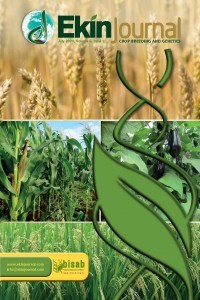Combining Ability Analysis and Heterotic Effects for Cotton Fiber Quality Traits
Combining Ability Analysis and Heterotic Effects for Cotton Fiber Quality Traits
cotton, fiber quality gene action, diallel analysis,
___
- Aguado, A, De Los Santos B, Gamane, D, Garcı´a del Moral, LF, and Romero F, (2010). Gene effects for cotton-fiber traits in cotton plant (Gossypium hirsutum L.) under Verticillium conditions. Field Crops Research. 116 (2010) 209-217.
- Aguiar PAD, Penna JCV, Freire EC, and Melo LC, (2007). Diallel analysis of upland cotton cultivars. Crop Breeding and Applied Biotechnology 7: 353-359.
- Ali Z, Khan TM, and Noorka IR, (2010). Diallel Analysis to Determine Gene Action for Lint Percentage And Fibre Traits in Upland Cotton. Int. J. Agric. Appl. Sci. Vol. 2, No.1.
- Ashokkumar K, Senthil Kumar K, and Ravikesavan R, (2013). Heterosis Studies for Fibre Quality of Upland Cotton in Linextester Design. African Journal of Agricultural Research. Vol. 8(48), pp. 6359-6365.
- Basbag S, Ekinci R and Gencer O, (2007). Combining ability and heterosis for earliness characters in line × tester population of Gossypium hirsutum L. Hereditas 144:185-190.
- Bhardwaj R P, and Kapoor CJ, (1998). Genetics of Yield and its Contributing Traits in Upland Cotton (Gossypium hirsutum L). Proceedings of the World Cotton Research Conference-2, Athens, Greece, pp. 214-216.
- Bhatade SS, Shobhane MR, and Unchegaonkar PK, (1980). Heterosis and Combining Ability in G. arboreum L. Indian J. Agri. Sci., 50:310-16.
- Bolek Y, Cokkizgin H, Bardak A, (2010). Combining Ability and Heterosis for Fiber Quality Traits in Cotton. Plant Breeding and Seed Science. Volume 62, Issue , Pages 3-16, ISSN (Online) 2083- 599X, ISSN (Print) 1429-3862, DOI: 10.2478/ v10129-011-0001-6, March 2011.
- Cheatham CL, Jenkins JN, Mc Carty JC, Watson C, and Wu J, (2003). Genetic Variances and Combining Ability of Crosses of American Cultivars, Australian Cultivars and Wild Cottons. J. Cotton Sci., 7: 16-22.
- Copur O, (2006). Determination of Yield and Yield Components of Some Cotton Cultivars in Semiarid Conditions. Pak. J Biol. Sci. 9(14):2572-2578.
- Ehsan F, Nadeem A, Tahir MA, Majeed A, (2008). Comparitive Yield Performance of New Cultivars of Cotton (Gossypium hirsutum L.). Pak. J. Life Soc. Sci. 6(1):1-3.
- Green CC, and Culp TW, (1990). Simultaneous Improvement of Yield, Fiber Quality and Yarn Strength in Upland Cotton. Crop Sci., 30: 66-69.
- Griffing B, (1956). Concept of General and Specific Combining Ability in Relation to Diallel Crossing Systems. Aust. J. Biol. Sci. 9:463-493.
- Hake KD, Bassett DM, Kerby TA, Mayfield WD, (1996). Producing Quality Cotton. In: Hake, S.J., Kerby, T.A., Hake, K.D. (Eds.), Cotton Production Manual. University of California Publication 3352, pp. 134-149.
- Hallauer AR, Miranda JB, (1981). Quantitative Genetics in Maize Breeding. Lowa State Uni. Press Ames. USA.
- Kanoktip K, (1987). Study on the Inheritance of Certain Agronomic Characteristics in Cotton. Field Crops Abs. Abs. No: 92-073564.
- Khan N, Basal H, Hassan G, (2010). Cotton Seed Oil and Yield Assessment via Economic Heterosis and Heritability in Intraspecific Cotton Populations. Afr. J. Biotechnol. 9(44):7418- 7428.
- Leidi EO, (2003). Combining Ability of Yield and Yield Components in Upland Cotton (Gossypium hirsitum L.) Under Drought Stress Conditions.
- Word Cotton Research Conference 3, Abstacts of Paper and Poster Presentations. s.337. Cape Town. South Africa.
- Lukonge EP, Labuschagne MT, and Herselman L, (2008). Combining Ability for Yield and Fibre Characteristics in Tanzanian Cotton Germplasm. Euphytica, 161 :3 83-3 89.
- Rauf S, Khan TM, and Nazır S, (2005). Combining Ability and Heterosis in Gossypium hirsutum L. International Journal of Agriculture and Biology. 7(1)109-113.
- Tanq M, Khan MA, Sadaqat HA, and Jamil T, (1992). Genetic Component Analysis. In Upland Cotton. J. Agric. Res., 30: 439-445.
- Ukai Y, (2006). DIAL98. User's Guide. Ver. 6. DIAL98. Japan.
- Verhalen LM, Murray JC, (1967). A Diallel Analysis of Several Fiber Properties Traits in Upland Cotton (G. hirsutum L.). Crop. Sci. 7:501-505.
- ISSN: 2149-1275
- Yayın Aralığı: Yılda 2 Sayı
- Başlangıç: 2015
- Yayıncı: Bitki Islahçıları Alt Birliği
Poaceae Weed Hosts of Yellow dwarf viruses (YDVs) in the Trakya Region of Turkey
Havva ILBAGI, Ahmet CITIR, Adnan KARA, Meryem UYSAL
Combining Ability Analysis and Heterotic Effects for Cotton Fiber Quality Traits
Suresh SURESH, Om Parkash BISHNOI, Rishi Kumar BEHL
Jagdeep SINGH1, Ashok Kumar CHHABRA
Public Popcorn Breeding Studies of Turkey
Sekip ERDAL, Ahmet OZTURK, Mehmet PAMUKCU, Erkan OZATA, Mehmet Cavit SEZER
Pritish JAKHAR, Yogesh KUMAR, Arun JANU
Amel BENSELAMA, Faiza OUAREM, Sihem TELLAH, S. Mohamed OUNANE, Ghania OUNANE
